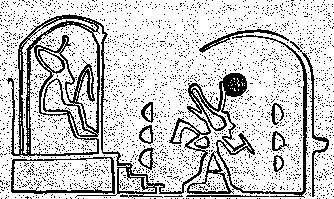|
This glyph too has two parts, at left a variant with only four solar months, as I have interpreted this type of glyph earlier, and at right a thread with feathers or something similar. Why are there just four months? And is the vertical line a sign for Venus-like behaviour? That we should count four here (and six in the case with three 'balls' on top of each other) is an idea - I believe - which receives support from the picture of the sanctuary of the ancient Egyptian wolf-god Upwaut, the 'Opener of the Way':
The Pharaoh is proceeding in the dark from one period of reign to the next. But then we should perhaps 'read' each vertical column of three semi-circles as not three months but twelve months? No, instead three items probably just stands for plural (more than two). And the semi-circles may be pictures of breads or bowls, with a symbolic meaning of feast. That is what I believe. But these semi-circles may have been 'translated' as month-signs by some early visitor to Egypt. That we should 'read' semi-circles and not circles with vertical diameters in the rongorongo texts is 'proved' by e.g. the glyph Eb6-1 (in the 24th period):
The 'thread' possibly is a part of this type of glyph (Eb6-15):
This idea struck me when I compared these glyphs:
|
||||||||

